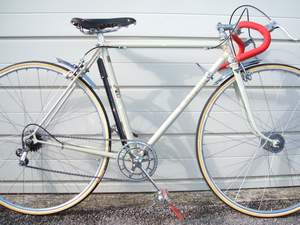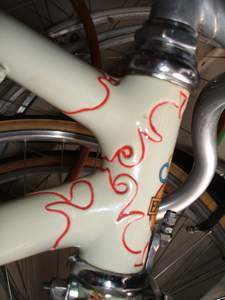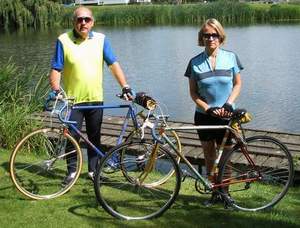Vol. 1, Issue 24
Posted: Friday 19th June 2020
One last snippet on the Titan bar/stem saga. At the Bates Weekend David Palk pointed out that a lot of these bars had a date stamp on the underside of the ferrule. I have checked ours, some do – some don’t. Sometimes components such as these can help to date a machine: as well as these bars Williams have a coded date on their chainwheels, etc. (I can send you a copy of the code if you don’t have it) and of course, early Sturmey hubs are clearly dated. Patricia has a 1951 Mal Rees (frame number 5211) which has the original 1949 Sturmey FM hub in it which is dated 49. I would guess the gear must have laid on the frame builders shelf for a couple of years.
We acquired this machine from the original owner who is sure of the date of manufacture as it was built in the year after she got married in 1950. Her husband used to go along to Mal Rees and watch their frames being built by ‘Slasher Bill’. He tells me that Slasher used to put a ‘doubler’ in the front inside of the chainstays to beef them up. This was mainly on the larger frames we think – the doublers can be seen from the inside of the B B. Having said that, I have never seen one done this way as there are not many Mal Rees about and Patricia’s does not have them. If I could find a nice 24” M R frame perhaps we could have ‘his and hers’ bikes – all we will need then is matching bobble hats – must get my knitting needles out.
In the last C L N Alex V T mentioned that for some years now he has had an early (old/unusual) pair of handlebars. On the left is engraved …Tour de France Brevete and on the right Renforce S. MAES, he wanted to date them if possible. Graham Bryce tells me that he has an identical pair which the previous owner assured him were original equipment on a 1939 machine.
Most people I know who have become interested in 50s lightweights start off with a classic frame and want to equip it with Chater cranks and pedals plus Conloys on Harden hubs and a Brooks saddle – the ultimate classic build I guess. This is exactly how we started (an Ephgrave No 1 frame for me and much later a Gillott for Patricia). After the first dozen or so builds (all right then three or four) the mind turns to the possibility of some variety here and there. I think this happened to us when John Spooner had an article in N & V (279 p34 Oct/Nov 2000) which showed a selection of the drives on his machines, the images showed the cranks, chainwheels and also the rear and front mechs, which was all very interesting. I must contact him to see if we can reproduce it.
A by-product of this way of thinking is an obsession about details which I realise shows up from time to time in C L N. Some oddball even thought it was unusual when I told him that I was going to catalogue all my freewheels over the Christmas holiday – it turned out I had some Simplex, TDC and Cyclo amongst all the ubiquitous Reginas. Life doesn’t get much better than that I can tell you – who needs Father Christmas. Must line up a project for this December, stems, chainrings, hubs – who can tell. My list also showed that I had a lot of close ratio blocks which are very nice in theory but don’t give the lower gears I work towards these days. I did manage to build up a 16-18-20-22-24 Regina block for my Osgear (on a 1948 Stallard Montlhery) as I thought the regular spacings would help to make for smooth changes.
I did this with a certain amount of juggling on the larger cogs after I obtained a 16-18 double cog for the smaller two and would like to build another one but cannot find a duplicate 16/18 which I would need to start off with. One problem with having a 24T sprocket is that it is as big as the Osgear spokeguard which makes it rather superfluous and it just looks silly hiding behind the large sprocket.
We recently had our annual pilgrimage to the Tin Can Ten, I took my 1951 Bates Vegrandis with SA FM gear and Patricia took her 1951 Mal Rees – also with SA FM. We didn’t put enough thought into it really as both our machines were geared down for hilly (Hampshire) events and both of us were spinning out in the higher gears whilst never using the lower ones. I am so afraid of Sturmeys that I never touch them once they are set up if at all possible. I must get over this phobia.
The following day we took part in Dave Fossard’s Golden Anniversary ride: 50 miles for fifties machines. This time the Bates gearing was ideal for the very ‘lumpy’ ride but Patricia had her Hetchins Swallow to ride on the second day and it attracted a lot of attention. The weekend was an introduction to the lightweights from this part of the country with several Paragon’s, Mercians and an Andy Bone plus one or two other makes from the Nottingham/Derby area.
Several people have told me that they have trouble with the FM: they cannot get the bottom gear to lock in on steep hills – just when you need them of course. The secret seems to be to change the normal way into bottom, keep the pressure on the trigger and start pedalling (spinning freely is no good, some pressure is needed) until you feel the trigger go click. This seems to do the trick.
Patricia is still playing ‘catch-up’ in a big way. She has acquired a 1950 Ephgrave No 1 which we are building with Chater round cranks, Simplex gears, GB engraved Capo Berta bars on Spearpoint GB stem and Fiamme sprints on Harden Bacon Slicer hubs. Brake stirrups are GB Hiduminium but the early GB levers I was going to use are too worn. They are the narrow ones with the darker hood and a brass adjuster which slots in the top. I have the adjusters which is half the battle but until I can find a good pair we have fitted some Doherty lookalikes. This is the priority build as she wants to ride it in the Ephgrave Ride which we are holding on September 4.


This image looks a bit washed out as the Ephgrave transfers are gold on a light coloured (Eau de Nil) frame. The lug lining in red really highlights the quality of these classic Ephgrave No 1 lugs. The 1A or 1 Super version has triangular cutouts in the ‘meatier’ areas of the lug.
Two other frames came with the Ephgrave: a 1948 Paris Tour de France with bi-laminated lugs at the head and a 1964 Pennine Richmond, both in need of restoration.
CHEAT’S CORNER Do you have a pair of Stronglight 3-arm steel cottered cranks but no bolts? I offered up 6mm bolts which were too small and 8mm bolts which were too big. Tony Beckett (Campag Marque Enthusiast and fount of technical knowledge) tells me that the correct bolts are in fact 7mm. They are quite hard to find as they are not often stocked by the average dealer. Following Tony’s instructions I contacted D Middleton of Unit 5, Lady Ann Mills, Lady Ann Road, Batley WF17 0PS. Tel: 01924 470807. Website www.stainlessmiddleton.co.uk .
From them I purchased ten M7 x 20mm stainless DS bolts – D= domed, S = set screws, (important as they need to be threaded all the way to the head) plus washers. These bolts can be shortened to 8mm which includes an allowance for a 1.5mm washer. The original bolts have a concave recess in the head. I have had 6 of the bolts cut down and the heads recessed so have two sets to use. They are 11mm across the flats and it is quite awkward to tighten them up as there is no room for a box spanner and it is very fiddly with an open ended one. It is even more difficult if the chainset is already fitted to the frame and you are too lazy to take it off!
Geoff Adams has a way of restoring the earlier worn GB brakes. They tend to get quite sloppy between the hood and the lever due to wear on the pivot. Geoff removes the pivot which is a shaft, threaded one end and with a screwdriver slot the other. He touches out the holes to 5mm and cuts down a SS bolt so that the smooth part of the shaft acts as a pivot and then cuts the thread to the (Short) length required. He then slots the other end to take a screwdriver. Unfortunately the last pair of Patricia’s he looked at were too far gone as the holes were about 50% oversize.

In News & Views No. 308, is a picture, taken on one of our rides, of the front end of a 1938 Pollard lightweight machine which is owned by Simon Sparrow of the Cambridge Section. He has some of the provenance of this machine as he purchased it from the son of the original owner. One of the reasons I took this image is to show the small-flange Harden hub which is very rare. Sharron V T has a pair on one of her machines but rumours that she married Alex just to get her hands on them are completely unfounded. I also have an image of the rear end of Simon’s Pollard showing the pre-war Huret gear.
In my teens, as a member of King’s Lynn Cycling Club, I spent (or mis-spent!) a lot of time with two other members, one Dickie Lines and the other Geoff Adams. Dickie was local born and bred whereas Geoff had moved to Norfolk from Coventry. Geoff and I (and Patricia) had a 44 mile mini-V-CC ride recently which took us to Denver Mill in Norfolk. Geoff was on his beautifully restored 1946 Super Special Hetchins so Patricia took her Hetchins Swallow along to keep it company (see picture taken at Denver). I could have made it a Hetchins hat-trick but especially wanted to give my Ephgrave No 1 road /path a run on fixed ready for the Ephgrave ride.
Anyway, back to Simon’s Pollard, Geoff was telling me that it was through Pollard that he got into cycling having gone to school with Eddie, the son of Bill Pollard who ran the business at the time. Bill had built Eddie a really special lightweight and it was this machine that convinced Geoff he must get out and start serious cycling with the local club. Bill Pollard started building lightweights in 1920 and his son Eddie retired from the business in 1990, during that time they hand-built 1898 frames between them. Eddie was a member of Coventry Wheelers and later the Coventry Road Club. Some collectors of cycles have a collection policy based on some format or other, sometimes geographical. I don’t know of a C L N reader who specialises in Coventry based machines although Sue Thorne, membership secretary of the V-CC is very much into Midlands-related cycle history. There is a short piece on Pollard cycles in Cycling Weekly of 31 May 1990 when Eddie retired. On the same page there is a photo of a very interesting 1937 Hobbs with Constrictor adjustable stem – I wonder if Mervyn Cook, Hobbs M E, has seen this.
I had a pleasant surprise today when a book arrived through the post. Unbeknown to me Patricia had ordered it for me after we had seen a copy at Dave Fossard’s ride a few weeks ago. The book is called The Condor Years – A Panorama of British Cycling 1945 – 2000 and is in paperback format, 27cm x 21cm. The book was produced with the help of Condor Cycles and they had generously asked that it covered the whole panorama of lightweight cycling rather than just be about Condor Cycles. The forward is by Alf Engers and the book has illustrations on virtually every page (over 200 in total). The author is Peter Whitfield and he has self-published it under the name of Wychwood, Tachbrook House, Charlbury, Oxfordshire OX7 3PS. Telephone: 01608 810837. I am only part way through at the moment but have enjoyed every page so far. It was £15 including P & P purchased direct from Peter Whitfield.
I had a phone call recently from Peter Nowell of Liverpool and the conversation got round to Chater chainsets and my attempts to make them run true (CLN 22). It was pointed out that when cranks are re-chromed sometimes the diameter of the axle hole is altered slightly (how I wonder) and makes for a slightly sloppy fit on the axle. When the cotter pin is tightened this causes the chainset to tilt to one side, hence to out of true running – back to the drawing board then. We also discussed the problem of holding the operating rod on a Simplex gear whilst tightening the nut to hold on the cage. He said that the only thing he knew to fit between the spring to hold the rod was a pair of dental forceps so take that Tour de France gear along the next time you visit the dentist.
We have a busy time ahead with three lightweight rides in the UK followed on October 2 by L’Eroica, a ride for classic cycles held at Gaiole, a Tuscan village near Siena. If all goes well with this event we may try to organise a small group for the ride in 2006 – quite a few readers are waiting to see how we get on. I have started to organise the packing of the bikes. We have two padded bike bags and I am constructing an alloy sub frame to bolt to the machine using the front and rear dropouts. I am using ¾” right angle alloy for the base and stronger flat alloy for the uprights The idea of this is to keep the chainwheel clear of the bottom of the bag as I have had them bent in the past. It will also space out both ends.
As Patricia’s gear is on a non-brazed hanger I took it off, moved it across and bolted it to the inside of the left-hand dropout. I am doing hers first as there is plenty of room in the bag as her frame is 19”. I guess my 24” frame may create more of a problem even though I expect to remove the seat and pin before packing. Another way round this could have been to remove the rings from the cranks but I want to speed things up for when we build the bikes on arrival. Watch this space!!
Posted: Friday 19th June 2020
This article appears in the following categories.
Upcoming Events
Whether you are looking for a gentle social meet up, or a 100-mile ride browse the community’s upcoming events and plan your next weekend outing.
